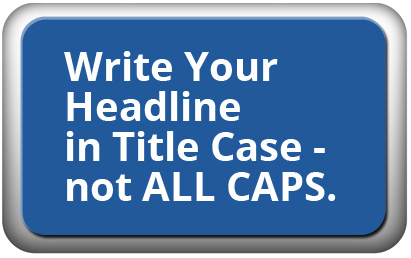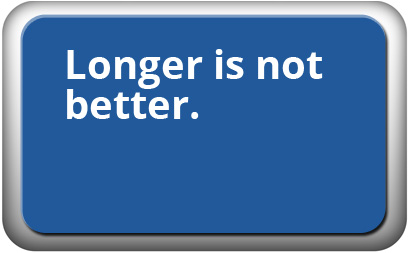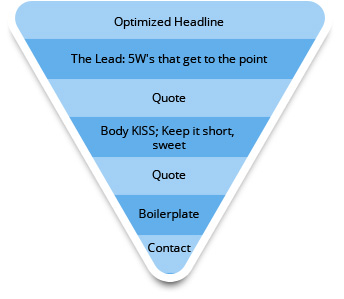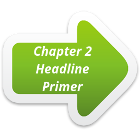How to Write a Press Release in 2021
Regardless of why you want to send out a press release – whether you’ve just published a book, your company is expanding (or would like to expand), you have a new product about to launch on Kickstarter, or maybe your organization is hosting a benefit gala – press releases are still a fantastic way to capture the public’s attention.
This guide will walk you through everything you need to know about writing a press release in 2021, including:
- How to generate story ideas that appeal to newsmakers
- How to compose gate-crashing headlines that get your news release opened
- How to create “Attention Funnels” that get your press release read to the end
- Solid PR techniques that keep your media release interesting, factual, and relevant
- What to do if / when a reporter calls
| Table of Contents | ||
|---|---|---|
| How to Write a Press Release: | Learn More About Press Releases: | Press Release Examples: |
| How to Format a Press Release | What is a Press Release? | Press Release for an Event |
| Headline: How to Get their Attention | What is a Press Release For? | Press Release for a Product |
| Lead and Body: Using the Inverted Pyramid | What Information Should a Press Release Include? | Press Release for a Business |
| Using a Great Quote | ||
| Closing: Call To Action and Boilerplate | ||
| Best Practices: Contact Info and Privacy | ||
| Headline | Humane Society Announces Annual Spay-ghetti and No-Balls Dinner | |
| Dateline | NASHVILLE, TN, Nov 10, YEAR (PR Newswire) | |
| Lead & Body | The Davidson County Humane Society announced that they will be holding its second annual Spay-ghetti and No-Balls Dinner on Saturday, December 20 at the Hilton Hotel on 123 Main Street in Nashville from 5:00 PM to 9 PM. All proceeds will go to support the Davidson County Humane Society, which is a no-kill shelter supporting Middle Tennessee. The menu includes spaghetti, vegetarian "no-balls", and gluten free options. Salad and dessert will be served and there will be a cash bar. The evening will include a pet fashion show featuring dogs who have recently been adopted and a variety of vendors will be selling crafts to raise money for the cause. It will be the perfect stop to pick up last minute holiday gifts. |
|
| Quote | Executive Director Rex Labradoodle said, "Last year, we raised over $12,000 and the support we get from the community touches us beyond words. We have a few surprises in store for our guests this year and we are appreciative to have a community that is passionate about putting homeless cats and dogs in loving homes. "Tickets for the Spay-ghetti and No-Balls Dinner are ten dollars and may be purchased on the humane society's website or at the door. To find out more how the shelter, how to volunteer, and adoptable pets, please visit the Davidson County Humane society at dchumane.org. | |
| Boilerplate | About Davidson County Humane Society The Davidson County Humane Society was founded in 1995, thanks to a generous donation by the late Jack Russell Bullmastiff. The organization is a 501(c) non-profit serving Davidson County, Nashville, and the entire Middle Tennessee region. The organization in a non-kill shelter that accepts strays, neglected/abused animals, and owner surrendered dogs and cats. To date, the shelter has rescued and placed 23, 500 animals and thanks to the support of the community, that number continues to grow. |
|
| Media Contact | Name of Media Contact: Rex Labradoodle Contact Phone: (555) 555-5555 Title of Media Contact: Executive Director Contact Email: [email protected] Company Name: Davidson County Humane Society Website URL: www.dchumane.org |
1.
Headline
British author Andrew Grant said, “You never get a second chance to make a first impression.” Oh, is this true of the press release – it’s the single most important element!
Your headline is the first impression a journalist will get of your story. Is it dull and flat? Is it loaded with sensationalist jargon? The headline should grab the reader”s attention while remaining truthful and relevant to your story. Make it stellar!
 ALL CAPS IS HARD TO READ, AND JUST COMES ACROSS AS OBNOXIOUS. Stick to title case as in the example to the left.
ALL CAPS IS HARD TO READ, AND JUST COMES ACROSS AS OBNOXIOUS. Stick to title case as in the example to the left.
Also consider including an optional subhead, which should be written in sentence format just underneath your headline. This isn’t required, but it can enhance the value of a great headline, and create even more interest in the rest of the press release. Remember: the goal is to elaborate on the headline without overshadowing the opening paragraph.
Our fictional news release above didn’t include a subhead, so let’s add one:
Humane Society Announces Annual
Spay-ghetti and No-Balls Dinner
The organization will look to raise over $12,000 for homeless cats and dogs.
More Tips:
- Cut the fluff, lose the sensationalism. ‘Fantastic’, ‘Great’, ‘Wonderful’, and ‘Life-Changing’ do not belong in headlines. Releases that contain industry-specific jargon and lots of editorial ‘bling’ come across as unprofessional and are ignored by reporters
- Go through your favorite paper. What caught your eye? Why? How does your own headline measure up? .
2.
Dateline
The dateline is the first line in the body of your press release. Standard form in all press releases, just follow the below formula and you”ll be fine.
The city and state should be that pertaining to the company/organization for which the release is being written; the date should reflect the date on which the release is being sent to the press.
3. Lead
Sentence +
Body
The opening sentence, or lead sentence, is another important element where you should succinctly summarize what is being announced. The opening paragraph should clearly get the reader’s attention through a strong hook while providing the most important facts.
As a best practice, write your press release first then come back and develop the opening paragraph as a summary of the press release. Then compare this new opening paragraph with your initial first paragraph.
There is an art to crafting the body as well, which makes for the bulk of your release.
First rule of thumb: to be a big fish and get noticed, you have to have strong hook for your lead sentence.
Jump to Chapter 3 to learn more about how to make your lead turn heads.
 The body should be three to six paragraphs in length. Longer is not better – journalists read hundreds of media releases per day, so don’t make conveying your story harder by giving them extra pages to read.
The body should be three to six paragraphs in length. Longer is not better – journalists read hundreds of media releases per day, so don’t make conveying your story harder by giving them extra pages to read.
Fill your body with content that relates directly to your opening sentence/headline. If it does not relate, leave it out.
So what should you include and when?
Background information. Who? What? Where? When? Why? This is often referred to as 5W Content.
So what information should you include? Consider the essential 5W Content:
- Who? Who is this about, and who does it affect?
- What? What is happening, and what does it mean?
- Where? Where is this taking place?
- When? When did/is/will this take place?
- Why? Why is this happening, and why do we care?
Once you have this information, consider arranging your release paragraphs as such:

4.
Quotes
A quote from you or a company exec does more than add significance to your release; if you and/or your company is quoted in a news story (or asked in for an interview), it positions you as an authority, and makes future news coverage even more likely.
Again, relevance is key here. There is an entire chapter dedicated to quotes alone, check it out!
Chapter 4 – learn everything you ever wanted to know and more about quotes in press releases.
5.
Boilerplate
The boilerplate goes at the very end of your press release, right before your contact information. It is a short paragraph that explains the identity of your company/organization and what it does. Boilerplates are optional, but it doesn’t hurt to have one. Think of boilerplates as a thumbnail sketch of your company that provides a little background information to the press. Once you’ve written a boilerplate, you can use it in all of your press releases.

6.
Contact
Info
Should someone reviewing your press release have question or need to get in touch with you, make it easy: include your contact information. This is something that should be included in every single release that ever leaves your desk.
At the very least, include the name and title of individual that the media can reach out to with questions.
Ideally, as a best practice, include the following:
Name of Person to Contact
Title of Person to Contact
Name of Company
(Phone)
(Email)
Full Website URL
Include a number to a person who knows about the content of the news release, and not a general phone number. Same goes with email. Direct the media to a specific individual, not just the general inquiry inbox.
Finished? End your press release with three pound signs, also knows as hash tag signs.

Final Word – AP Style Writing
Final tips: Familiarize yourself with AP Style writing. The AP Stylebook is a journalist’s Bible. If you aren’t familiar, this is the go-to book for the journalistic style used by the United States news industry.
No, you do not have to memorize the book, but it might be helpful to grab a copy. This is the preferred style for just about every editor and journalist in the biz, but the stringency with which this is upheld has been vastly loosened thanks to texting and social media.
Frequently Asked Questions
Most of today’s media content starts with a purposefully crafted press release. The answers to this set of frequently asked questions give you the tools that you need to write press releases that get your information noticed by journalists.
What is a Press Release?
A press release is a document that’s specially crafted to get media attention. The media is a powerful extension of modern society that can be used to shape the way people think about your company or cause. A news release gives a journalist the facts about a newsworthy event so that he or she can investigate further and write a compelling story. When written correctly, press releases deliver a win for all involved.
While a well-written press release is a valuable tool when used solo, it’s best submitted as part of a comprehensive public relations (PR) strategy. Public service activities, special events, and executive-level speeches all work together with press releases to make your brand or idea worthy of media attention.
The standard release, the media advisory, and the embargoed release are the three common types of media releases. A standard press release shares information with journalists about a milestone event and contains general facts about the company that sponsored the publication. A media advisory press release informs the media about an upcoming press conference. An embargoed press release gives journalists time-sensitive data and statistics that are meant to be made public by the press at a specific date.
In the past, only large businesses, non-profit organizations, and government agencies used press releases. Now, small and medium-sized businesses, entrepreneurs, and every day people submit news releases to shed light on new products and services, essential industry facts, and responses to crises. Sometimes it’s difficult to distinguish a potent press release from a poor one. Here are samples of click-worthy press releases.
What Are Press Releases Good For?
A news release helps you and your business tell your stories to the public. A journalist takes critical facts from your press release and writes a compelling story for his or her audience, which can range from theatergoers to science buffs. Here are some specific ways that press releases are used to influence readers.
Address an Allegation
Adhering to fair labor practices throughout supply chains is a significant issue with many companies. A clothing company can use a press release to answer allegations about unsafe work conditions in its supplier’s factory.
Release a New or Innovative Product or Service
A company can use a press release to tell about an artificial intelligence-based back-office upgrade that allows it to process customer requests 30 percent faster.
Announce a Political Candidate
Whether one loves or hates politics, political candidates continue to gain media attention through press releases. A new candidate will often submit a media release to journalists to announce his or her bid for a position. When the political climate turns nasty, political candidates also use news releases to set the record straight about misconduct allegations.
Tell About a Record-Setting Sales Boom
Improved sales numbers affect the brand image and stock prices. Many companies waste no time announcing sales booms to the public via press releases.
Present Industry Statistics
Investors armed with timely and relevant information about an industry make better funding decisions. Independent professional associations send media releases that contain data about industry trends and threats.
Publicize a Book Release
Releasing a new book is an exciting time for an author. Authors make sure that their target audiences know about book releases, book tours, and book signing sessions via press releases.
What should be Included in a Press Release?
Whether a PR person writes a standard press release to introduce a new service or a media advisory press release to announce a press conference, he or she follows a specific format that’s preferable to journalists and editors. The acceptable length of a news release is 300 to 500 words. With this limitation, PR people must write succinct press releases. Here are six elements that always appear in successful media releases.
Headline
A press release headline tells journalists the purpose of the press release in a one-line statement that’s 60 to 80 characters in length. If a headline isn’t engaging, most journalists will pass on writing a story about it.
Dateline
Datelines appear in the first line of press releases. Their job is to state when the press release was written and the city and state of its origin.
Opening Paragraph
Besides the headline, the opening paragraph is one of the essential parts of every press release. It has information that hooks readers by giving them the critical details of the announcement in an executive summary-style format.
Body Paragraphs
The body section of a news release is at the heart of the document. It usually consists of three to five paragraphs that give more details about the announcement that the writer described in the headline and the opening paragraph.
Information about the Company
General information about the company or individual who sponsored the media release appears as a paragraph near the end of the document. This paragraph supports the brand and name recognition.
Contact Information
When a journalist has questions about a press release, he or she can look for the point of contact for the news release at the end of the document. Contact information includes a representative’s name, title, email address, and phone number.
How to Write a Press Release for an Event?
Writing a press release is a great way to get the word out about events such as charity galas, fun runs, and the opening nights of theatrical shows. The key to crafting a successful event press release is to give the audience facts about the event that is exciting enough to share.
Writing an engaging event press release starts with some research about the intended audience. The audience for the press announcement can include journalists, editors, or social media influencers who cater to a specific readership. For instance, a PR person would write a media release for an antique charity auction that highlighted an upscale lifestyle. He or she would target media persons who write for lifestyle or career publications.
Journalists are trained to scan news releases for the who, what, when, where, how, and why information about the event. Smart PR people give them what they want in the standard press release format. After reading an event press release, the journalist should know about the event’s purpose, setting, and desired attendees.
Proofreading event press releases is a crucial activity that novice writers often miss. Grammatically correct media releases are easier to read. Also, submitting event press releases that announce incorrect event dates and addresses wastes everyone’s time and lowers the credibility of event sponsors.
How to Write a Press Release for a Business?
A newsworthy topic is the first thing to consider when writing a business news release. The great news is that a writer can make a variety of issues newsworthy based on the language that he or she uses. Some common business media release topics include the launch of a new business, a company merger, and the adoption of a new process that’ll impact service quality.
A concise, fact-rich headline is a must for a business press release. Journalists favor business media releases that quickly tell them the who, what, when, where, and why information about business events. “Maryland’s First Vegan Omelets Cafe Will Open in Baltimore Next Friday” is an example of this type of headline. This headline tells journalists that a new diner is opening, the variety of customers who’ll be interested in eating there, and when patrons can head to the eatery for this dining experience.
A writer continues to give journalists important information about the new restaurant, such as its address and atmosphere in the opening paragraph. He or she then uses data, statistics, and quotes by industry influencers in the body of the press release to show why the restaurant is a treasure for Baltimore residents. Fact-based press releases lend more credibility to new businesses than ones that use advertising language.
How to Write a Press Release for a Product?
Before crafting a product press release, consider your audience. Most journalists specialize in specific news categories. While one covers politics, another focuses on environmental issues. If you want media coverage about the launch of your new solar-powered smartphone, you’ll want to capture the attention of the journalist who covers sustainability news and not the one who focuses on politics.
You must craft an exciting headline that introduces your product, shows its uniqueness, and highlights its primary benefit. The opening paragraph will give details about your product’s features and how your company plans to introduce it to the market. In the body of the product press release, you should provide data and statistics that support the claimed benefits of the new product. Quotes by subject matter experts reinforce the credibility of the content like news and not just sales copy.
Regular readers love a good story, and journalists do too. Seasoned writers of product press releases weave in the product’s backstory into the content. Based on the above example, you would explain what motivated you to develop the new device.
Providing contact information is a critical part of a product press release. Since standard news releases are less than 500 words, they’re not likely to list the product’s full technical specifications. When a journalist has questions about the product’s performance features, he or she will use the contact information at the end of the press release to get clarification. Reputable journalists also fact-check the information in media releases, and they may want to ask you for the sources of your data.
How do Press Releases Work?
The goal of every press release is media attention. You want multiple journalists to write stories about your event, new business, or new product launch. However, you’re competing with hundreds of other people for the attention of the same set of journalists daily. Set yourself apart from the rest by developing professional relationships with the media.
You should understand that each press release creates a touchpoint with a busy journalist. So researching target journalists who cover stories about your company’s causes and products is a must. Each news release serves to generate buzz about a topic and build rapport with a target audience of journalists.
Long-term relationships with journalists are developed by submitting press releases often. When journalists get single media releases about new product launches from unknown small businesses, they usually pass on writing stories about the products because they are unfamiliar with the companies. After they see a collection of news releases from those companies in news categories that they cover, they start to notice the company and its newsworthy content.
While PR departments of some well-known corporations submit newsworthy news releases weekly, small businesses do well to make monthly press release submissions. When journalists make contact or write a story based on a press release, those companies strike while the iron is hot and respond quickly to requests for information.
After making media contacts, keep in touch with targeted journalists to develop long-term relationships with them. After you’ve cultivated strong business relationships with a select number of journalists, submit your press releases directly to those media personalities via email. In this case, you have a higher chance of getting a steady stream of positive media attention via press releases.
Where Do You Send Press Releases?
Unless writers have already established contacts for journalists in their field, they’ll rely heavily on a newswire to distribute their press releases to the right set of journalists. When writers send press releases to a newswire, they select the categories that most fit their content. Journalists look at newswires daily to find material for good stories in the news categories that they cover.
The four leading newswires are PR Newswire, Business Wire, and GlobeNewswire. PR Newswire and Business Wire are the oldest and most respected newswires; they are called Tier 1 newswires because journalists usually look for press releases on these wires first. GlobeNewswire is a Tier 2 newswire. When sending press releases to newswires, writers must follow the newswire’s submission standards that guard against defamation, nudity, and advertisements.
When considering where to send press releases, writers must consider their budgets. Currently, it costs over $1200 to send a 500-word press release to a Tier 1 newswire for distribution. Submitting the same press release to a Tier 2 newswire for delivery costs $500 to $700.
Press release distribution services also offer small business owners convenient ways to send press releases to newswires.
Are Press Releases Worth it?
Submitting press releases have many benefits. The most prominent advantage is the cost-effective way that they can create awareness about your company and your products and services. Advertising space in leading magazines, newspapers, and online publications cost businesses up to $80,000 per quarter page. A journalist’s story about a company and its product or service requires you to pay only newswire submission fees.
Besides getting an inexpensive buzz about your company, you’ll also gain credibility with consumers. People trust news more than advertisements. When a journalist writes a favorable article about a company’s new product, readers expect a story that isn’t biased by commercial motivations. These types of stories spark interest and influence shopping habits.
Submitting press releases to a newswire is a great way to extend your reach to your intended audience. Traditional journalists aren’t the only people who read the newswires regularly. Alternative media reporters, influencers, bloggers, and fact-checkers compete with mainstream media journalists to break stories in a variety of categories. When writers send press releases to newswires, those news releases reach an extended group of influencers.
Press releases allow you to build your reputation in a crowded marketplace and help you attract investors.
How to Send a Press Release – Don’t tarnish your good name spamming editors!

